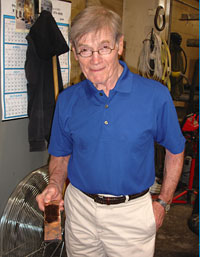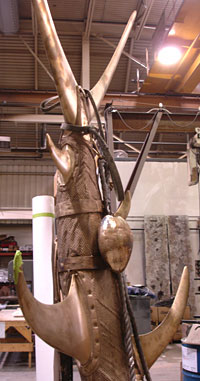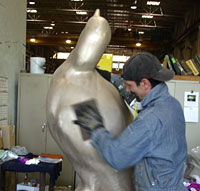An Inside Look at Polich Tallix Fine Art Foundry
 Dick Polich, owner of Polich Tallix
Dick Polich, owner of Polich TallixPhotograph by Paul David
For more than 40 years, Dick Polich has helped bring fine art to life through the timeless process of lost wax casting. His full-service fine art foundry, Polich Tallix, tucked away in scenic Rock Tavern, New York, crafts some of the world's most recognized and well-crafted sculptures.
Notable artists Jeff Koons, Nancy Graves, Frank Stella and Louise Bourgeois are just a few of the artists who have had their work cast in bronze before being set free at museums, galleries, universities and parks throughout the world.
Situated in a building as large as a football field with 40-foot ceilings, there are no limits. Polich-Tallix has the ability to grow 6-inch model up to 60 feet, repair sculpture damage, create replicas of dinosaurs, and engineer the unimaginable.
"There are all levels of creativity possible in any human endeavor. Blessedly, this is the kind of business that we do!" says Polich, the founder and CEO of Polich-Tallix.
One gets the impression that every day of the last 40 years Polich has felt like a sweet-toothed kid strutting through his very own candy store. He approaches his clients' projects with a careful, inquisitive countenance, and demonstrates deep sincerity toward keeping artists' ideas intact. Yet in his success he has never lost a bit of playfulness and innovation. Although the foundry had changed legal owners over the years, it now rests in the very capable hands of its original founder.
 A bronze work created using lost wax
A bronze work created using lost waxPhotograph by Paul David
Before the foundry had become even a twinkle in his eye, Polich was a Yale scholar, a Navy man, and aspiring architect. The son of parents from Yugoslavia who grew up on the west side of Chicago, Polich went on to receive a Masters in Metallurgy from MIT. Polich-Tallix is the largest foundry in the United States, and the only one with a metallurgist on staff.
The massive foundry he now owns began in a small garage in 1968, with Polich as the only employee. Now it employs 180 highly skilled craftsmen, and nearly half of them have been working at Polich-Tallix for 20 years or more.
Polich is extremely proud of his employees' longevity of careers at the foundry, and sees it as living proof that he has created a community of craftsmen who are all highly skilled and consistently challenged by the demands of artists' imaginations.
At a fine art foundry there is a very special relationship between artists and craftsmen. Polich believes that the job of the metal foundry is to approach new artists and their ideas with a sense of respect and appreciation. "We are not critics, we are not going to make an artist's work better than it was or would be. We are there to make it the way you want us to make it," he says.
One thing that the public doesn't always understand is that the artist is often not the person who has made that object you admire on a family vacation to a Revolutionary War battlefield or a visit to the MoMA. Project Manager Jimmy Jolly, who has been with Polich-Tallix over 30 years, says "People think the artist must have done that… and while some artists are very hands-on, very few of them have that skill."
Polich-Tallix's craftsmen have cultivated the skills, and are always adapting to new technology that has changed foundry work over the course of four decades. "I describe myself as a ringmaster in a circus," Polich explains about his role within the foundry.
 Inside the studio at Polich Tallix
Inside the studio at Polich TallixPhotograph by Paul David
When an artist approaches him with an idea, it is his goal to achieve that concept with flawless execution, but not to influence the artist's opinions. "I throw up a balloon and say, 'How 'bout that one?' If that doesn't work, 'How bout this one?' " Polich embraces new technology and introduces new techniques to the artists that he thinks will help best achieve their idea, or make it more cost-effective, for example. "There is my willingness to try new approaches, but also my sense of boundaries. My effort is the same, whether the sculpture is right-side up, upside-down. The ultimate goal is to make it so that a knowledgeable person can look at it and say: 'That's well made.' "
Polich-Tallix attracts high-profile clients because they consistently make exquisitely well-made pieces. One of the processes used fairly often at the foundry is a molding process known as lost wax casting . The metal of choice-bronze, for example-will become the final sculpture when it replaces a temporary wax area inside of a mold. A casting like this can be thought of in terms of positive and negative space, with a mixture of ceramic, sand and glue applied as a protective coating on the outside. In its final stages, the cast is placed into a pressurized steam tank where the wax on the inside is evaporated. Technicians then fire the cast until it is hardened into a hollow shell awaiting bronze, steel, or another metal of choice to be poured inside. Once the fire-red metal is heated liquid-hot, the cast is placed in a tank and surrounded by sand to provide outward pressure to avoid explosions. Technicians in protective gear pour the molten lava metal into a small hole in the cast where it is left to cool for the finishing process, which may include sanding and patinas, depending on the desired aesthetic.
 Artist Todd McGrain, working on a series of bronzed extinct birds for the Audobon Society
Artist Todd McGrain, working on a series of bronzed extinct birds for the Audobon SocietyPhotograph by Paul David
"The thing that the foundry swings around, the song of our universe," says Polich, "is the melting and casting of metal. Here we are in this primitive thing of having changed this incredibly hard material that flows like water and then poured it into a cast. The next day we open it up, it's like Christmas. Every day we go through that, which to me seems like a celebration of creativity."
Polich-Tallix is currently working on two high-profile projects in New York City, one a prototype for the 9/11 Memorial and another a memorial for Frederick Douglass, which will be installed at the newly constructed Frederick Douglass Circle on the northwest corner of Central Park. Artist Gabriel Koren's Frederick Douglass Memorial consists of a white bronze constellation wall representing the star-lit map to freedom for the slaves in America. From the west side of the constellation wall an elegant waterfall will cascade down, and you can see it best from a walkway with a railing made of 34" diameter wagon wheels. The memorial culminates in a statue of the famed abolitionist in silicon bronze-a special metal patented by Dick Polich. Polich-Tallix Project Manager Jimmy Jolly anticipates installing the sculpture work in early May, 2009, with the final memorial's dedication taking place in July.
Resources:
Polich Tallix, 453 Route 17K, Rock Tavern, NY, (845) 567-9464
Also in this Issue:
- An Inside Look at Polich Tallix Fine Art Foundry
- Carol B. Saylor: In Her Mind's Eye
- Syed Ahmad: Capturing Fluid Movement in Glass on Copper
- Transcendence Through Copper
- MAD Museum Exhibits Elegant Armor: The Art of Jewelry
